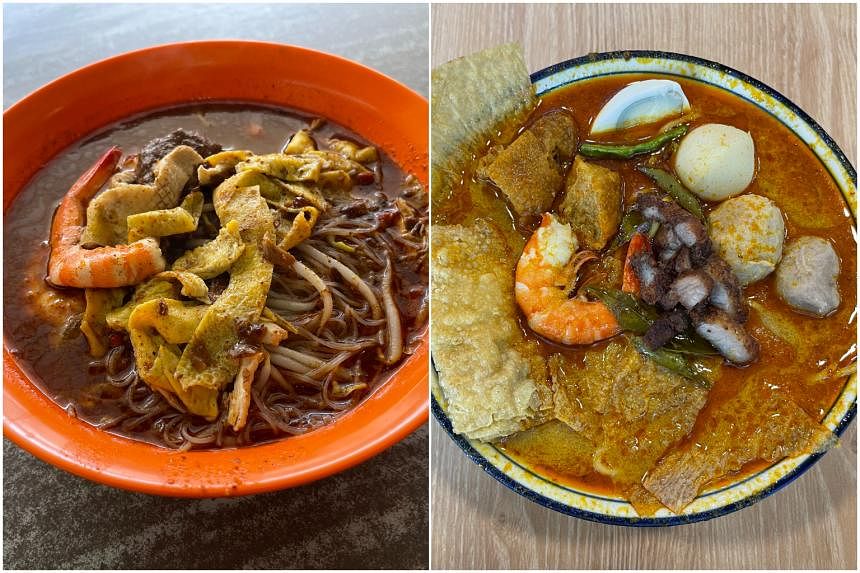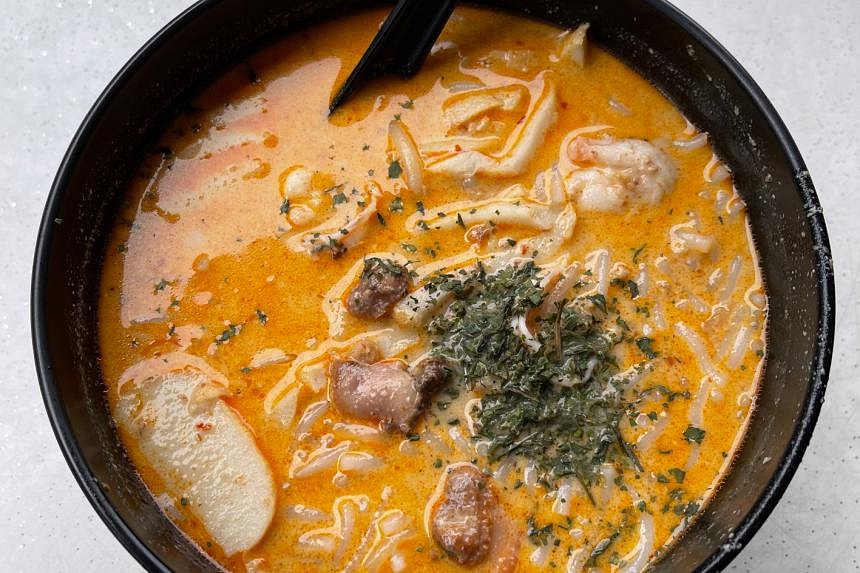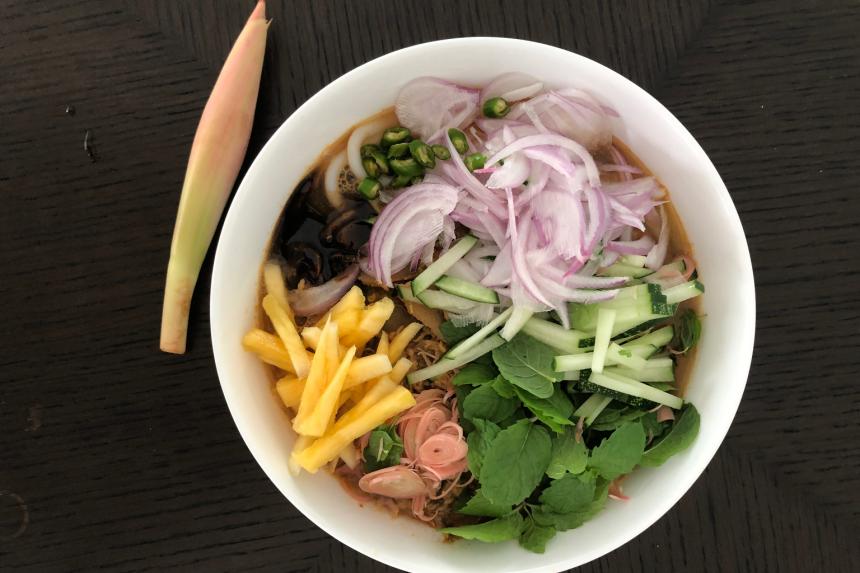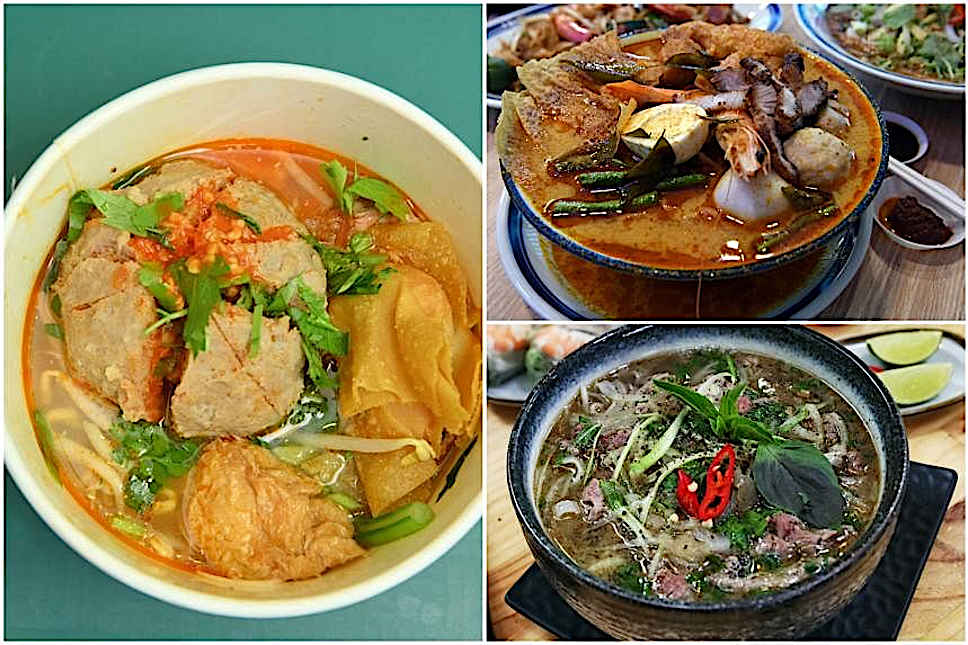What's that you're slurping: A guide to laksas you can get in Singapore

While laksa for most Singaporeans means a noodle dish in a spicy, orange broth thickened with coconut milk, it comes in many other forms in neighbouring Malaysia.
In recent years, many of these have popped up here, with resident Malaysians selling dishes that their fellow countrymen are missing from home. So, besides the familiar Penang laksa, you can now find versions from other regions like Sarawak and Ipoh.
The latest newcomer is Selayang curry noodle, hawked by Nan Yang Dao, a Malaysian eatery in Serangoon Central. It is inspired by a popular dish found in Selayang town in Selangor.
What is known as laksa in Malaysia is often spicy and often does not contain coconut milk. When that is added, the dish is usually termed curry mee, and more specifically curry laksa in Kuala Lumpur.
Sadly, no one here has replicated my favourite curry laksa from a wet market stall in Kuala Lumpur's Chinatown I have been patronising since the 1970s.
It is still at its original spot, along a grimy alley called Madras Lane - named after a cinema owned by Shaw Brothers that was burnt down in 1978 and never rebuilt.
The noodles are topped with taupok (beancurd puff), long beans, brinjal, pig skin and lots of cockles - all of which go so well with the spicy broth they are bathed in.
Which is your favourite laksa? Here is a guide for you to demystify its origins and ingredients. Enjoy.
Katong Laksa

Named after the area in the east of Singapore where the dish was created by the Peranakans living there, this version is distinguished by the generous amount of coconut milk in the broth. That makes it creamy and aromatic, and very lemak (rich).
It is typically served with cockles and strips of fishcake. The thick beehoon is cut into short strips, so that it can be eaten with just a spoon. The idea is to enjoy the noodles together with the broth with every spoonful.
With popular stalls expanding by opening new outlets or franchising, Katong laksa is now found throughout the island.
Where to get it
My favourite is 328 Katong Laksa in East Coast Road for its balance of spiciness and aroma. The broth, while creamy, is not too lemak to drink up to the last delicious drop. The stall has branches in Queensway Shopping Centre, United Square and Westgate. A bowl starts at $5.50.
Singapore Laksa

This is the most common and oldest version of laksa here. Done well, the blend of fiery spiciness and milky fragrance hits the spot and is particularly comforting on a rainy day.
The broth is less lemak than Katong laksa, but contains more coconut milk than Malaysian curry mee - a nice balance.
Toppings typically comprise cockles, fishcake, hard-boiled egg and taupok. More deluxe versions served in hotel cafes may include prawns or even half a lobster. Many hawkers also toss in chopped daun kesom, more commonly called laksa leaves, for added fragrance.
The default is to eat the dish with thick beehoon, known as laksa beehoon. But I prefer to eat it with thin beehoon as it picks up the gravy better. There is also less chance of the strands slipping from the chopsticks and splashing gravy on your clothes.
Where to get it
Check out Guang Fa Laksa (above), an old-school stall in Havelock Cooked Food Centre. It has a delicious gravy and comes with juicy cockles and smooth strips of fishcake. Prices start at $3.
A surprisingly good version ($4) can be found at Teochew Fishball Minced Meat Noodle in Peck Hoon Teng Eating House along River Valley Road. The broth is very good, but a drawback is that the noodles do not come with cockles.
Sungei Road Laksa in Jalan Berseh is also excellent, but its $3 bowl is tiny. There is only one size and I need two bowls to fill me up.
Ipoh Curry Mee

This noodle dish from Ipoh, the capital of Perak state that is better known for its gai see hor fun (shredded chicken rice noodle soup), has grown more visible here with new stalls opening in the past year.
The gravy resembles Singapore laksa, but with less coconut milk. Except for taupok, the toppings are totally different.
There is roast pork, char siew and shredded chicken, as well as long beans, mint leaves and fresh lime. Some stalls include deep-fried pig skin, but there are no cockles.
Where to get it
One of the older stalls selling Ipoh curry noodle is Yap's Noodles, at level three of CapitaSpring since April. It has been around since 2018 in Yishun Park Hawker Centre, but that stall is now open only on weekends. A bowl costs $7.
Jian Zao Ipoh Curry Noodles, which opened in Ang Mo Kio in September last year, also does an authentic version (above). Prices start at $5.50.
Selayang Curry Mee

This is a new dish (above) introduced to Singapore by Nan Yang Dao, an eatery in Serangoon Central specialising in Malaysian food that opened in March.
It is named after a town in Selangor state next to Kuala Lumpur in Malaysia, and is inspired by a popular noodle dish from Coca Seafood Restaurant there.
The jumbo bowl of noodles is a gourmand's dream. The huge serving comes with an amazing array of toppings - I count 10 - that includes a prawn, roast pork, pork ball, fishball, Fuzhou fishball, deep-fried beancurd roll, fried beancurd skin, taupok, long beans and hard-boiled egg.
Where to get it
As far as I know, Nan Yang Dao is the only place selling this dish for $9.90. It comes only with yellow noodles, though I prefer egg noodles, beehoon or a mix of kway teow and yellow noodles to soak up the gravy better. Order this only if you have a hearty appetite.
Sarawak Laksa

Except for the fact that the broth is cooked with a spice paste, there is little that is similar between Sarawak and Singapore laksa.
The noodle dish from the East Malaysian state does not contain coconut milk, nor cockles, beancurd puffs or fish cake. Instead, you find toppings of chicken, prawns and omelette strips in a mildly fiery broth that is aromatic with spices. It is usually served with thin beehoon.
Where to get it
There are about 10 stalls here selling Sarawak laksa, often together with kolo mee, a popular dry noodle dish also from the Malaysian state.
There are two stalls in Haig Road Market & Food Centre. Lin Yu Mei Sarawak Laksa is one of them, but I am more impressed with the version (above) at unit 01-51, where the signboard reads: "Sarawak Kolo Mee. Laksa."
While both have good gravies, you get a bigger bowl for the same $6 with better quality toppings at 01-51.
Other places to enjoy the dish include Ian-Tau Ban Seng Sarawak Laksa in Toa Payoh Lorong 1, Just Sarawak Laksa in Bishan Street 11 and Sarawak Delicacy Laksa & Kolo Mee in Bedok North Street 1.
Penang Laksa

This is probably the Malaysian laksa most familiar to Singaporeans, with many Penang eateries and hotel buffets here serving it since the 1980s.
Also called assam laksa, it bears no resemblance to the Singapore version.
The broth, which is cooked with ikan kembong (mackerel), tamarind and aromatic herbs such as galangal and lemongrass, is more sour than spicy. And it is dark brown in colour, not orange nor red.
Although the recipe calls for chillies in the spice mix used to cook the broth, most of the detectable heat comes from freshly cut red chillies used as a topping.
Other garnishes include strips of pineapple, cucumber, onions, lettuce, as well as sprigs of mint. Lashings of inky fermented prawn sauce are added to give the broth more depth and mellow out the acidity from the tamarind.
In Malaysia, the dish uses a thick translucent noodle called lai fun in Cantonese, made with a blend of rice and tapioca flours that results in a slightly springy texture.
But in Singapore, hawkers use the local thick beehoon made with rice flour that is softer and breaks easily.
Where to get it
The best version of assam laksa here is served at Penang Seafood Restaurant in Aljunied Road, where the soulful flavour belies its messy appearance. A serving of the noodles smothered in a layer of fish meat starts at $4.
You can also get a very good version at the Penang Hawker Fair that is organised by York Hotel a few times a year. The next pop-up is from Sept 2 to 18 to coincide with the school holidays. The buffet, which includes 12 other hawker favourites, is priced at $38 on weekdays and $42 from Fridays to Sundays.

Gurney Drive, a new eatery in Northshore Plaza II, also serves a credible version for $5.90.
For a late-night fix, go to Super Star Original Famous Penang Laksa in People's Park Food Centre. It opens from 2 to 11pm daily and a bowl of laksa costs $7.50.
Join ST's Telegram channel and get the latest breaking news delivered to you.









No comments:
Post a Comment